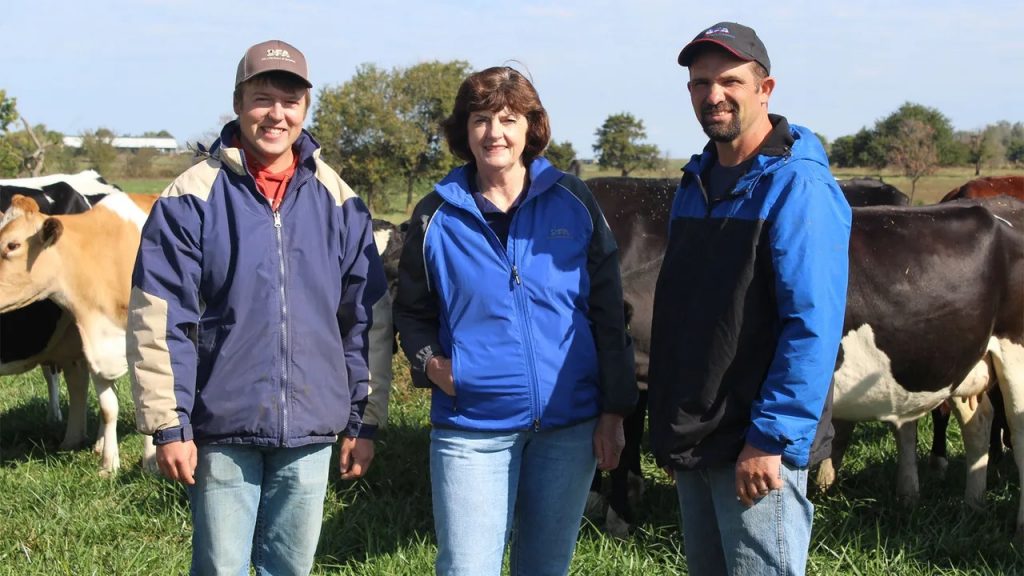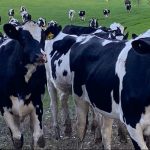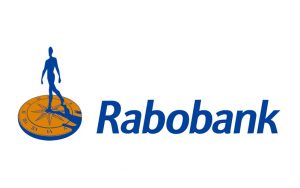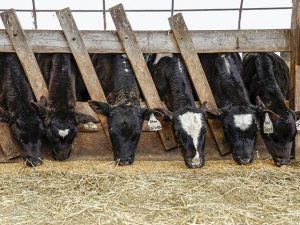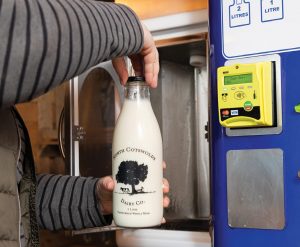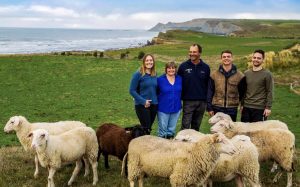
From two heifers to 200 cows, a Missouri woman’s dairy farm defies odds and celebrates resilience despite industry decline.
At 6 a.m., Marilyn Calvin is opening the gate, letting the first set of cows into the milking parlor. The 14-unit automatic takeoff milkers are a far cry from the stanchion and surge bucket milkers that started the Thunder Ridge Dairy operation 50 years ago.
While equipment changes, the passion for the land, the livestock and the industry remains the same.
“When we got married, he had a bird dog, a shotgun and a car payment,” Marilyn says of her late husband, Kenneth, who died of an aneurysm in 2009. “I had two Holstein heifers. And that’s how we got started.”
While their time was cut, that did not deter Marilyn from continuing in the dairy business.
Since running the first milk cow through the stanchion on Thunder Ridge Dairy, Marilyn watched as 95% of the nation’s dairy farms shuttered their operations — 5% in 2024 alone to a tune of nearly 15,000 dairy farms in a 12-month period.
“Labor issues are a part of the problem, but really, it’s economics and the ups and downs of prices,” she says. “During COVID-19, since we are in a Class 1 market, we saw our pay price go to half. And then feed and input prices all went up — feed and fertilizer skyrocketed. That was probably the hardest time we’ve been through, including the 1980s.”
Marilyn realizes dairy farming isn’t for the faint of heart. It is a labor of love.
At 6 a.m., Marilyn Calvin is opening the gate, letting the first set of cows into the milking parlor. The 14-unit automatic takeoff milkers are a far cry from the stanchion and surge bucket milkers that started the Thunder Ridge Dairy operation 50 years ago.
While equipment changes, the passion for the land, the livestock and the industry remains the same.
“When we got married, he had a bird dog, a shotgun and a car payment,” Marilyn says of her late husband, Kenneth, who died of an aneurysm in 2009. “I had two Holstein heifers. And that’s how we got started.”
While their time was cut, that did not deter Marilyn from continuing in the dairy business.
Since running the first milk cow through the stanchion on Thunder Ridge Dairy, Marilyn watched as 95% of the nation’s dairy farms shuttered their operations — 5% in 2024 alone to a tune of nearly 15,000 dairy farms in a 12-month period.
“Labor issues are a part of the problem, but really, it’s economics and the ups and downs of prices,” she says. “During COVID-19, since we are in a Class 1 market, we saw our pay price go to half. And then feed and input prices all went up — feed and fertilizer skyrocketed. That was probably the hardest time we’ve been through, including the 1980s.”
Marilyn realizes dairy farming isn’t for the faint of heart. It is a labor of love.
As members of Dairy Herd Improvement Association and registered breed organizations for more than 50 years, registration is an important part of Thunder Ridge Dairy. Marilyn says it is a way for the operation to keep up with genetics and maintain the quality they have become known for.
“Registration adds value to our cows,” she explains. “When we have cows to sell, we’re confident in what we are selling, and the buyer is confident in what they are buying. They know they have the genetics behind them to work for their herd.”

NEW SYSTEM: Dairy cattle graze in pastures outside of Mount Vernon, Mo. They will rotate through each paddock as part of a new system put in place by Marilyn Calvin. It helps manage forage resources and labor demands at the small farm. (Photo courtesy of Marilyn Calvin)
Make most of every acre
One of the achievements Marilyn is most proud of in recent years is the introduction of a new grazing system to the family dairy farm.
“We put in a 160-acre intensive grazing system that includes two 80s [acres] here where the dairy is. The system has several different 3- to 5-acre paddocks with lanes and automatic waterers in each,” she explains. “It has made a big difference in our grazing and the way we are able to utilize our forage. We change paddocks every couple of days to get the most from our grazing.”
The automatic waterers in each paddock have also made a difference in animal welfare. Marilyn notes that the cows don’t have to travel far for water.
“Everything is right there, and that really does a lot for their contentment,” she adds, “and we’ve seen fewer foot problems. In fact, it’s hard for us to find a hoof trimmer because we are no longer on a schedule with anyone.”
The freshened cows are kept on the homeplace, where the dairy is, while the replacement heifers and dry cows are at other farms, farther away.
“We try to utilize every acre to its fullest potential. We have bottom ground and my son Kenlee’s place on Spring River that we double-crop because we can’t graze,” Marilyn says. “We usually put up high-moisture triticale, rye — those types of forages — in high-moisture bales and then wrap them. After we cut the hay, we will go back in with corn and chop it for silage. We’re feeding everything that we’re growing.”

HELPING OTHERS: Marilyn Calvin is pictured with Jon Bebermeyer. Both are winners of the Missouri Dairy Hall of Honors Leadership Award. (MU Extension)
Giving back to dairy industry
In January, the Missouri Dairy Hall of Honors presented Marilyn with its Dairy Leadership Award in recognition of a lifetime of service to the industry and Missouri agriculture.
“I started with Mid-Am as a district delegate and then I was the district chairman; and then I was asked to run for the Mid-American Dairyman Southern Division board in 1994,” she says, trying to keep the dates, positions, boards and chairs straight as she recalls a lifetime of service. “When Dairy Farmers of America was formed in 1998, I was on the corporate board — I was actually one of the founding board members of DFA and Midwest Dairy Association in the same year.”
Marilyn says that the late 1990s were an exciting time for the dairy industry as cooperatives came together to form DFA and secure a better milk price.
She served on the DFA Southeast Area Council in 1998 and still serves as Ozarks Division vice chair and corporate board member of Midwest Dairy Association, and is a member of Missouri Dairy Association.
Beyond the dairy industry, Marilyn served on the Lawrence County Farm Service Agency committee for 20 years, first as a minority adviser and then in an elected position for three, three-year terms, the most allowed. She is still the only woman to be elected to the committee to date.
For several years, she served as chair for the University of Missouri Southwest Research Center committee. She is the first woman to be inducted into the Missouri Institute of Cooperatives Hall of Fame.
Though the days were long, she says she’s proud of her service.
“I know that there are other dairy farmers out there working hard and struggling, trying to keep their dairy operations going, just like we are,” she says. “The most meaningful thing another dairy farmer has ever said to me is, ‘I know that you’re out there working for us and trying to help us. To know that other dairy farmers know I’m working for them makes it all worth it.’”
Handke writes from Easton, Kan.
You can now read the most important #news on #eDairyNews #Whatsapp channels!!!
🇺🇸 eDairy News INGLÊS: https://whatsapp.com/channel/0029VaKsjzGDTkJyIN6hcP1K
